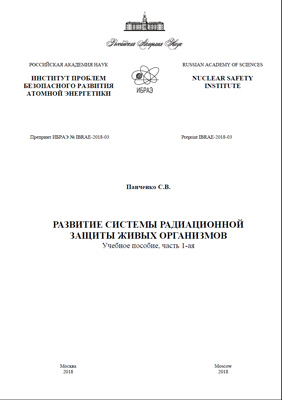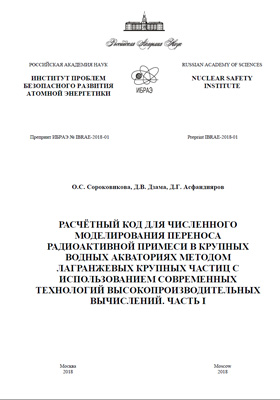| Русский / English |
|

|
NUCLEAR SAFETY INSTITUTE OF THE
RUSSIAN ACADEMY OF SCIENCES
|
PREPRINTS
 | Specialized graphical editor for developing the 3D models of nuclear- and radiation-hazardous facilities and converting the geometrical parameters into the format of the Monte Carlo codes (preprint IBRAE-2018-05) Preprint IBRAE-2018-05 Blokhin P.A., et al. In this article, the description of developed specialized graphical editor GRATOR intended for development of 3D graphical models and their conversion into the format of a calculation programs is presented. Within the scope of graphical editor development the algorithm of automatized preparation of input data for the calculation modules of program complex intended for modeling the radiation fields from the ionizing radiation sources is realized. The specifics of graphical models creation considering their further use in the calculation programs is shown, and examples of the developed models of nuclear waste container as well. Bibliographical reference P.A. Blokhin, Yu.E. Vaneev, I.V. Sipachev. Specialized graphical editor for developing the 3D models of nuclear- and radiation-hazardous facilities and converting the geometrical parameters into the format of the Monte Carlo codes / Preprint IBRAE-2018-05. — Moscow : NSI RAS, 2017. — 11 p. — Bibliogr.: 11 items. © Nuclear Safety Institute, 2018 |
 | Review of existing approachs to modeling of dispersal of radioactive substances in surface water objects in the framework of development of CPS "BAKIS" (Preprint IBRAE-2018-04) Preprint IBRAE-2018-04 Nosov A.V., et al. Computational prognostic system (CPS) "BAKIS" is designed to simulate the dispersal of radioactive impurities in surface water objects of land and to forecast the radiation impact from their contamination on population and water biota. One of the purposes of its development is the need to justify the safety of existing and decommissioned radiation hazardous facilities, whose activities can affect water objects both by direct discharges of radioactive substances and through contamination in case of accidental atmospheric releases. The paper provides an overview of existing software tools that can be used to perform calculations of various complexity levels for flowing or weakly flowing water objects, describes the imposed constraints, which require the development of new, more functional software solutions. A detailed description of existing mathematical models of impurity transport in the aquatic environment taking into account auxiliary models, as well as description of approaches to assessing the exposure doses for population due to water use and radiation impact on aquatic biota is given. Bibliographical reference A.V. Nosov, A.L. Krylov, D.V. Aron, V.P. Merkushov. Review of existing approachs to modeling of dispersal of radioactive substances in surface water objects in the framework of development of CPS "BAKIS" / Preprint IBRAE-2018-04 — Moscow: NSI RAS, 2018 — 43 p. — Bibliogr: 54 items. © Nuclear Safety Institute, 2018 |
 | Development of the system of radiation protection of living organisms (preprint IBRAE-2018-03) Preprint IBRAE-2018-03 Panchenko, Sergey The emergence of radiobiology and radiation protection system is considered in the first part of review. The fundamental principles of radiobiology are regarded since the science occurrence until the mid-1960s. They have determined the evolution of approaches to the formation of an international system of radiation safety. The paper is written for students studying radiobiology and radioecology, and can also be of interest to everyone who is fond of the history of natural sciences. Bibliographical reference Sergey Panchenko. Development of the system of radiation protection of living organisms. / Preprint IBRAE-2018-03. Moscow: Nuclear Safety Institute, 2018. — 53 p. © Nuclear Safety Institute, 2018 |
 | In the origins of radioecology (preprint IBRAE-2018-02) Preprint IBRAE-2018-02 Panchenko, Sergey The development of radioecology in Russia and the USSR as an independent scientific discipline, which grew up in the 20th century from radiobiology and ecology is shown in this paper. The study of the history of radioecology in Russia and in the whole world acquires special significance in connection with the issues of ensuring radiation and environmental safety of nuclear industry enterprises, the oil industry and other industries where the application of radioecological monitoring is required for enterprises. This work is written as part of the course on radioecology, which is taught to students of the Moscow Institute of Physics and Technology at the Department of Problems of the Safe Development of Modern Energy Technologies. Bibliographical reference Sergey Panchenko. In the origins of radioecology. / Preprint IBRAE-2018-02. Moscow: Nuclear Safety Institute, 2018. — 36 p. © Nuclear Safety Institute, 2018 |
 | Computational software for numerical modelling of dispersion of radioactive contamination in large water areas by a Lagrangian puff-particle model realized on state-of-the art high-performance computational technologies. Part I. (preprint IBRAE-2018-01) Preprint IBRAE-2018-01 Sorokovikova O.S., et al. In this paper computational software for numerical modelling of dispersion of radioactive contamination in large water areas is presented. One of the main purposes of this software is to localize water areas that are appropriate places for environmental monitoring and sampling. Localization of those areas, where contamination peaks might be expected, combined with appropriate measurement campaigns running in them, can be used to justify a more extended sampling strategy in case of increase in pollution levels and can be indicative of a possible breach in protective barriers. The software is based on a Lagrangian stochastic puff-particle dispersion model. The model employs multi-year ocean currents databases in various large water areas obtained through reanalysis of the coupled ocean-atmosphere circulation based on data assimilation. In this paper a detailed description of the main assumptions and the key processes is given as well as the characteristics of currents needed to run a simulation. Bibliographical reference O.S. Sorokovikova, D.V. Dzama, D.G. Asfandiyarov. Computational software for numerical modelling of dispersion of radioactive contamination in large water areas by a Lagrangian puff-particle model realized on state-of-the art high-performance computational technologies. Part I. / Preprint № IBRAE-2018-1. – Moscow: NSI RAS, 2018. – 29 p. – Bibliogr.: 24 items. © Nuclear Safety Institute, 2018 |
 | International experience in deep geological disposal of SNF and RW. Part 3. International experience in the development and operation of underground research laboratories (Preprint IBRAE-2017-12) Preprint IBRAE-2017-12 Cebakovskaya N. S., et al. This paper continues a series of publications summarizing current international experience in the establishment and operation of underground research laboratories and deep geological repositories for spent nuclear fuel and long-lived radioactive waste. This paper overviews current international experience in the establishment and operation of underground research laboratories (URL). The first part introduces international classification of URL types, the key R&D tasks, as well as the changing role of URLs at different stages during the stepwise repository development. The paper provides an example of R&D strategic planning approach developed in the U.S. — repository development matrix comprising rows and columns, where the rows are key activities and the columns are the phases in the repository development timeline from an early research and development phase to later phases such as construction, operations, and closure. The second part provides a general description of R&D performed in four underground research laboratories in granite formations (Switzerland, Sweden, Canada, Finland). Bibliographical reference Cebakovskaya N. S., Utkin S. S., Pron I. A., Konovalov V. Yu. International experience in deep geological disposal of SNF and RW. Part 3. International experience in the development and operation of underground research laboratories. Preprint IBRAE-2017-12 — Moscow: Nuclear Safety Institute, 2017 — 34 p. — Bibliogr: 20 items. © Nuclear Safety Institute, 2017 |
 | Development of calculation methods for estimating the migration of radionuclides beyond the engineering safety barriers, taking into account their evolution (Preprint IBRAE-2017-11) Preprint IBRAE-2017-11 Boldyrev K.A., et al. Computational methods of the complex RPK B Destruct (Degradation struture) is presented. It designed to take into account the evolution of engineering safety barriers in the assessment of migration of radionuclides beyond their limits. Calculation models of leaching from glass matrices, corrosion of metallic, degradation of concrete, evolution of bentonite safety barriers are presented. Examples of calculation of test tasks are given. Bibliographical reference K.A. Boldyrev, D.V. Kryuchkov, K.V. Martinov, A.S. Nuzhny, V.V. Suskin. Development of calculation methods for estimating the migration of radionuclides beyond the engineering safety barriers, taking into account their evolution / Preprint IBRAE-2017-11 — Moscow: Nuclear Safety Institute, 2017 — 23 p. — Bibliogr: 33 items. © Nuclear Safety Institute, 2017 |
 | Social consequences of the Three-Mile-Island accident and the role of radiation risk perception (Preprint IBRAE 2017-10) PreprintIBRAE-2017-10 Melikhova E.M. The paper considers all different social consequences of the Three-Mile-Island accident in comparison with those of non-radiological disasters. It is concluded that one can explain all but one social consequences of the Three-Mile-Island accident by governmental decisions during the acute phase. The consequences of the radiological emergency with a real but not realized threat of radiation fallout did not differ much from those of natural disasters with official calls for evacuation and without any physical damage (“false alarm”). Only development of social relationships in local communities followed the specific scenario of a technogenic accident with “chronic” pollution of the environment. The social tension resulted from polarization of local residents’ opinion on severity of health hazards persisted for decades. Comparison of governmental decisions taken on negligibility low radiation risk with those taken in the case of chronic chemical contamination of urban territories in Love Canal, NY, revealed one crucial difference: the decision makers’ exaggerated fear of potential health hazards from radiation. It is this particular fear that paves the way for long-term negative social tension in local communities, even if radiation risk is much less than socially acceptable risk levels. Bibliographical reference E.M. Melikhova. Social consequences of the Three-Mile-Island accident and the role of radiation risk perception / Preprint IBRAE 2017-10. Moscow: Nuclear Safety Institute, 2017. — 32 p. |
 | Dose coefficients to estimate the external gamma irradiation effect upon different kinds of biota (Preprint IBRAE-2017-09) Preprint IBRAE-2017-09 Blokhin P.A., et al. Estimation of dose impact upon the biota gradually becomes mandatory requirement by substantiation of safety for objects of radiation danger. The wide specter of radionuclides and enormous number of biota kinds makes one to search for universal ways for development of corresponding calculation methods. This article shows the results of dose coefficients calculations of external irradiation for different kinds of biota typical for Russian Federation from radionuclides emitting by decay γ-rays with energies from ≈ 0.1 to 2 MeV. The scenarios of referent species being in the air, water, ground, and on the surface of earth are examined. Bibliographical reference P.A. Blokhin, P.A. Kizub, S.V. Panchenko. Dose coefficients to estimate the external gamma irradiation effect upon different kinds of biota /Preprint IBRAE-2017-09. — Moscow: NSI RAS, 2017. — 44 p. — Bibliogr.: 11 items. © Nuclear Safety Institute, 2017 |
 | Algorithm of automation of input data preparation for modeling the transfer of ionizing radiation (Preprint IBRAE-2017-07) Preprint IBRAE-2017-07 Blokhin P.A., et al. The paper presents the algorithm description of the input data automated preparation for calculation modules of the program complex designed for modeling the radiation field from sources of ionizing radiation. Bibliographical reference © Nuclear Safety Institute, 2017 |
 |
IBRAE RAN © 2013-2026 | Site map | Feedback |